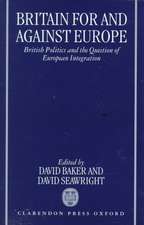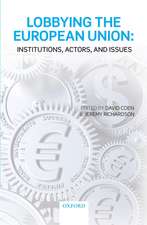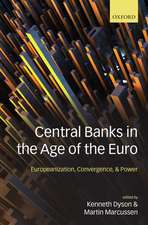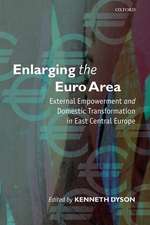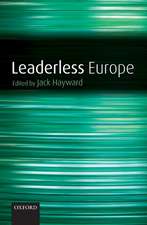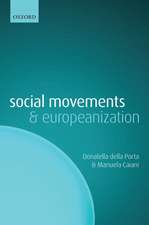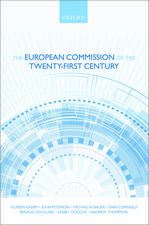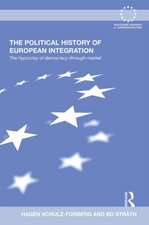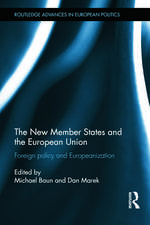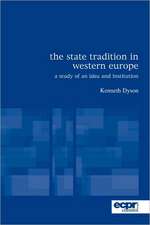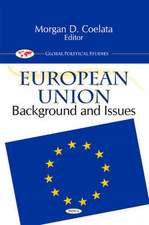Architects of the Euro: Intellectuals in the Making of European Monetary Union
Editat de Kenneth Dyson, Ivo Maesen Limba Engleză Hardback – 18 aug 2016
Preț: 588.54 lei
Preț vechi: 842.67 lei
-30% Nou
Puncte Express: 883
Preț estimativ în valută:
112.65€ • 117.16$ • 94.40£
112.65€ • 117.16$ • 94.40£
Carte tipărită la comandă
Livrare economică 03-10 martie
Preluare comenzi: 021 569.72.76
Specificații
ISBN-13: 9780198735915
ISBN-10: 019873591X
Pagini: 328
Dimensiuni: 169 x 234 x 23 mm
Greutate: 0.62 kg
Editura: OUP OXFORD
Colecția OUP Oxford
Locul publicării:Oxford, United Kingdom
ISBN-10: 019873591X
Pagini: 328
Dimensiuni: 169 x 234 x 23 mm
Greutate: 0.62 kg
Editura: OUP OXFORD
Colecția OUP Oxford
Locul publicării:Oxford, United Kingdom
Recenzii
This book is a success because it illuminates the role of the architects' stores of knowledge, skills, passions and interests in the process of European Monetary Unification . . . the book is relevant to the current challenges facing the Euro Area and, with it, the lives of the millions of people inhabiting it.
Architects of the Euro is a rich and stimulating book.-
It is often claimed, perhaps particularly by its detractors, that European Economic and Monetary Union was mainly created by an elite. This book records the identity, thinking and objectives of such key protagonists. It is an important study of political economy, how ideas and structures develop, an essential part of the political and economic history of our times. I am delighted to have played a minor role in the exercise, put together by Kenneth Dyson and Ivo Maes, to deploy the best historians of political economic thought, to illuminate the process by which EMU was constructed.
This remarkable volume by eminent scholars will help readers to better understand what the intellectual underpinning of the euro was and where it eventually proved wanting. It shows well how unprepared the system was to deal with the recent crisis and what are the challenges to fix it.
The originality of Architects of the Euro, edited by Dyson and Maes, is that it brings out the vital role played by ten senior officials and policy-oriented economists, well chosen by the editors, in starting the process towards the euro. Despite major differences in views, these architects had a shared motivation to start with what appeared at the time both economically justified and politically feasible, leaving the completion of the work-in-progress for later challenges.
This book, Architects of the Euro, is an impressive work on the personalities who built in a technical way the European Monetary Union. It is also useful for those readers willing to revise economic, and sometimes political, ideas about the Euro, from the creation of the European Community to the recent economic crisis.
In a model of historiography, Dyson and Maes assemble biographical vignettes of ten economists and economic policymakers, including Robert Triffin and Jacques Delors, who helped establish the euro,' 'demonstrates the value of sophisticated syntheses of policy analysis and intellectual history.'
This book is welcome for those who want to understand the complex process of getting to the single currency, while taking into account the driving forces of the individual personalities who were at the origin of the major ideas. The human aspect is never far away. In that respect, the biographic sketches are interesting reading which brings ideas in a historic and human perspective. For example, the way Otto Pöhl defended his vision in the Delors Committee and in Germany, including the concept of the independence of the Central bank, reads almost like a thriller.
With their collection of essays on high level bureaucrats the Architects of the Euro Maes and Dyson have broken new ground. The editors and their authors provide first-hand biographical accounts of these so far neglected figures and use them to explain their actions during the constitutive phase of the European monetary integration.
Architects of the Euro is a rich and stimulating book.-
It is often claimed, perhaps particularly by its detractors, that European Economic and Monetary Union was mainly created by an elite. This book records the identity, thinking and objectives of such key protagonists. It is an important study of political economy, how ideas and structures develop, an essential part of the political and economic history of our times. I am delighted to have played a minor role in the exercise, put together by Kenneth Dyson and Ivo Maes, to deploy the best historians of political economic thought, to illuminate the process by which EMU was constructed.
This remarkable volume by eminent scholars will help readers to better understand what the intellectual underpinning of the euro was and where it eventually proved wanting. It shows well how unprepared the system was to deal with the recent crisis and what are the challenges to fix it.
The originality of Architects of the Euro, edited by Dyson and Maes, is that it brings out the vital role played by ten senior officials and policy-oriented economists, well chosen by the editors, in starting the process towards the euro. Despite major differences in views, these architects had a shared motivation to start with what appeared at the time both economically justified and politically feasible, leaving the completion of the work-in-progress for later challenges.
This book, Architects of the Euro, is an impressive work on the personalities who built in a technical way the European Monetary Union. It is also useful for those readers willing to revise economic, and sometimes political, ideas about the Euro, from the creation of the European Community to the recent economic crisis.
In a model of historiography, Dyson and Maes assemble biographical vignettes of ten economists and economic policymakers, including Robert Triffin and Jacques Delors, who helped establish the euro,' 'demonstrates the value of sophisticated syntheses of policy analysis and intellectual history.'
This book is welcome for those who want to understand the complex process of getting to the single currency, while taking into account the driving forces of the individual personalities who were at the origin of the major ideas. The human aspect is never far away. In that respect, the biographic sketches are interesting reading which brings ideas in a historic and human perspective. For example, the way Otto Pöhl defended his vision in the Delors Committee and in Germany, including the concept of the independence of the Central bank, reads almost like a thriller.
With their collection of essays on high level bureaucrats the Architects of the Euro Maes and Dyson have broken new ground. The editors and their authors provide first-hand biographical accounts of these so far neglected figures and use them to explain their actions during the constitutive phase of the European monetary integration.
Notă biografică
Kenneth Dyson is a Fellow of the British Academy, a Fellow of the Royal Historical Society, a Founding Fellow of the Learned Society of Wales, and Research Professor in European Political Studies at Cardiff University. His research interests encompass the European state, German policies and politics, comparative and international political economy, and the EU. His recent publication States, Debt, and Power: 'Saints' and 'Sinners' in European History and Integration (OUP, 2014) won the UACES Best Book Prize.Ivo Maes is Senior Advisor at the Research Department of the National Bank of Belgium and a Professor, Robert Triffin Chair, at the Université Catholique de Louvain, as well as at ICHEC Brussels Management School. In 2003, he was a member of the Committee for Institutional Reform of the West African Monetary Union. He has been a visiting professor at Duke University (USA), the Université de Paris-Sorbonne and the Università Roma Tre. He is the Chair of the Council of the European Society for the History of Economic Thought.

